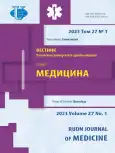Cardiorespiratory fitness and body fat percentage in young adults
- Authors: Soni H.1, Kacker S.1, Sorout J.1, Saboo N.1
-
Affiliations:
- Rajasthan University of Health Sciences College of Medical Sciences
- Issue: Vol 27, No 1 (2023): GINECOLOGY
- Pages: 83-89
- Section: Physiology
- URL: https://journal-vniispk.ru/2313-0245/article/view/319730
- DOI: https://doi.org/10.22363/2313-0245-2023-27-1-83-89
- EDN: https://elibrary.ru/UKAHJP
- ID: 319730
Cite item
Full Text
Abstract
Relevance. Maximal oxygen consumption (VO2max) is the maximum amount of oxygen an individual can breathe in and utilize it to produce energy aerobically. The global epidemic of overweight and obesity -’globesity’ is emerging as a public health problem in many parts of the world. Almost 30-65 % of adult urban Indians is either overweight or obese or has abdominal obesity. Recently, cardiovascular ailments are increasing in the younger generation. Low levels of cardiovascular fitness and unfavorable cardiovascular risk profiles are detected in them. Total body fatness and aerobic capacity are frequently used in association with each other and it is often implied that these parameters are strongly inter-related. Both body fatness and status aerobic fitness have been shown to be risk factors for future health outcomes. The aim of this study was to assess the correlation of cardio-respiratory fitness with body fat percentage in young adults. Materials and Methods. This was a pilot study conducted in a group of 100 subjects of age group 18 to 25 years. Ethical clearance was obtained from institutional ethical committee and written informed consent were taken from all subjects participated in the study. Following parameters were taken (a) anthropometric parameters, (b) body fat percentage, (c) physical activity level and (d) VO2max. Results and Discussion. The mean ± SD for age, height, weight, global physical activity questionnaire (GPAQ score) and VO2max was found to be higher in male participants as compared to female participants while BMI was almost equal in both the genders but body fat percentage was higher in female participants. There was positive non-significant correlation of VO2max with body mass index and global physical activity in female subjects but positive significant in male subjects. And moderate negative correlation between body fat percentage and VO2max in male and female subjects but not significant (p > 0.05). Conclusion. Body fat percentage was negatively correlated with maximum oxygenconsumption (VO2 max).
About the authors
Harsha Soni
Rajasthan University of Health Sciences College of Medical Sciences
Email: nehasaboo8@gmail.com
ORCID iD: 0000-0002-1638-7209
Jaipur, Rajasthan, India
Sudhanshu Kacker
Rajasthan University of Health Sciences College of Medical Sciences
Email: nehasaboo8@gmail.com
ORCID iD: 0000-0001-8947-2036
Jaipur, Rajasthan, India
Jitender Sorout
Rajasthan University of Health Sciences College of Medical Sciences
Email: nehasaboo8@gmail.com
ORCID iD: 0000-0002-1510-0982
Jaipur, Rajasthan, India
Neha Saboo
Rajasthan University of Health Sciences College of Medical Sciences
Author for correspondence.
Email: nehasaboo8@gmail.com
ORCID iD: 0000-0002-3874-1459
Jaipur, Rajasthan, India
References
- Plowman SA, Smith DL. Exercise Physiology for Health, Fitness, and Performance. 4th ed. Philadelphia: Lippincott Williams & Wilkins; 2014. The Cardiovascular System. p. 353.
- Treacher DF, Leach RM. Oxygen transport-1. Basicprinciples. BMJ. 1998;317(7168):1302-06. doi: 10.1136/bmj.317.7168.1302.
- Levine BD. VO2max: what do we know, and what do we still need to know? J Physiol. 2008; 586:25-34. doi: 10.1113/ jphysiol.2007.147629
- World Health Organization [Internet] Geneva: WHO obesity and overweight fact sheet; [accessed 2022 June 25]. Availablefrom: http://www.who.int/mediacentre/factsheets/fs311/en/
- World Health Organization. Obesity: preventing and managing the global epidemic: report of a WHO consultation. World Health Organization; Geneva: 2000. p. 253.
- Misra A, Chowbey P, Makkar BM, Vikram NK, Wasir JS, Chadha D. Consensus statement for diagnosis of obesity, abdominal obesity and the metabolic syndrome for Asian Indians and recommendations for physical activity, medical and surgical management. J Assoc Physicians India. 2009;57:163-70.
- Misra A, Khurana L. Obesity-related non-communicable diseases: South Asians vs White Caucasians. Int J Obes. 2011;35:167-187. doi: 10.1038/ijo.2010.135
- National Health and Nutrition Examination Survey (NHANES) Anthropometry Procedure Manual. 2007:2-10.
- Durnin JV, Womersley J. Body fat percentage assessed from total body density and its estimation from skin fold thickness: measurement on 481 men and women aged from 16 to 72 years. Br J Nutrition. 1974; 32(1):77-79. doi: 10.1079/bjn19740060
- World Health Organization. Global Physical Activity Questionnaire (GPAQ) Analysis Guide, 2018. [accessed 2022 June 25]. Available from: https://www.google.com/url?sa=t&rct=j&q=&esrc=s&source=web&cd=&cad=rja&uact=8&ved=2ahUKEwiSj4r1opH6AhVs7TgGHeq8D8kQFnoECBoQAQ&url=https%3A%2F%2Fapps.who.int%2Firis%2Fbitstream%2Fhandle%2F10665%2F272722 %2F9789241514187-eng.pdf&usg=AOvVaw0rghKRuqgGKVTFb3SGvic3
- Verhs PR, Geordge JD. Submaximal treadmill exercise test to predict VO2 max in fit adults. Measurements in physical education and exercise science. 2007;11(2): 61-72. doi: 10.1080/10913670701294047.
- Chhabra P, Chhabra SK. Distribution and determinants of body mass index of non-smoking adults in Delhi, India. J Health Popul Nutr. 2007;25(3):294-301.
- Mungreiphy NK, Renu MD, Tyagi KS, Kumar A, Tungdim MG. Ethnicity, obesity and health pattern among Indian population. J Nat SciBiol Med. 2012;3(1):52-59. doi: 10.4103/0976-9668.95955.
- Singh A, Purohit BM. Evaluation of Global Physical Activity Questionnaire (GPAQ) among Healthy and Obese Health Professionals in Central India. Baltic Journal of Health and Physical Activity. 2011;3:34-43. doi: 10.2478/v10131-011-0004-6
- Exercise AC. Ace Lifestyle and Weight Management Consultant Manual, The Ultimate Resource for Fitness Professionals. American Council on Exercise. 2009. p. 526. Available from: https://www.google.com/url?sa=t&rct=j&q=&esrc=s&source=web&cd=&ved=2ahUKEwjyovq1zLL8AhUdSmwGHWhSC4AQFnoECBQQAQ&url=https%3A%2F%2F
- Karastergiou K, Smith SR, Greenberg AS, Fried SK. Sex differences in human adipose tissues - the biology of pear shape. Biol Sex Differ. 2012;3(1):13. doi: 10.1186/2042-6410-3-13
- Chang E, Varghese M, Singer K. Gender and Sex Differences in Adipose Tissue. Curr Diab Rep. 2018 Jul 30;18(9):69.
- Turnley J. VO2max: how can an endurnce athlete use it to obtain peak performance. [accessed 2022 June 25]. Available from: https://docplayer.net/14053031-Vo2max-how-can-an-endurance-athlete-useit-to-obtain-peak-performance-by-jheri-turnley-b-s-hfs-abstract.htm
- Shah H, Prajapati T, Singh SK. Association of body mass index with VO2max in Indian adults. Int J Basic Appl Physiol 2016;5:155-9. doi: 10.5455/njppp.2021.11.01042202108022021
- Goran M, Fields DA, Hunter GR, Herd RL, WeinsierHeymann. Total body fat does not influence maximal aerobic capacity. Inter J of Obesity. 2000;24:841-48. doi: 10.1038/sj.ijo.0801241
- Davies CTM, Godfrey S, Light M, Largeant AJ, Zeidifard E. Cardiopulmonary response to exercise in obese girls and young women. JAP. 1975;38:373-76. doi: 10.1152/jappl.1975.38.3.373
Supplementary files









